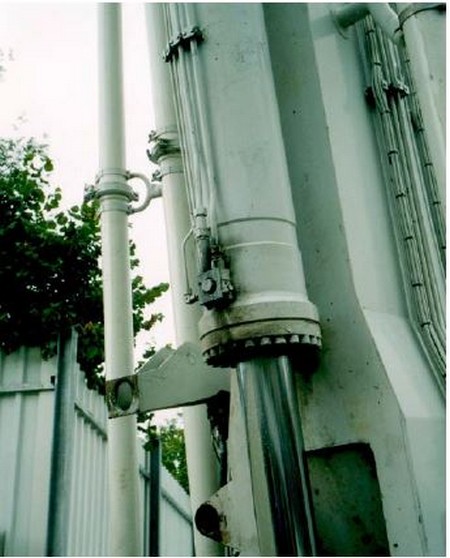Abschnitt 4.4 - 4.4 Hydraulic cylinders
Before starting to replace hydraulic cylinders, they have to be free of all forces, e. g. caused by elevated loads. Furthermore, it has to be paid attention to the fact that depressurization is implemented on both the piston and the rod side ( see figure 18).
The technical data of replacement cylinders have to comply with those of the types to be replaced.

Fig. 18
Hydraulic cylinder with pilot-operated check valve
In order to prevent unforeseeable sudden parts movements caused by residual air in the cylinders, the latter have to be filled with hydraulic fluid and vented by several extracting and retracting procedures in idle in the service workshop or via the system hydraulics before they are installed. If this is not implemented automatically, the ventilation has to be implemented manually on the piston and rod side. In doing so, possibly existing bleeding screws have to be used. The fittings must only be re-tightened when the leaking oil is free of bubbles.
If sealing plugs are used after the hydraulic cylinders have been filled, it is important to remove them before installation. This is particularly important on the piston rod side, in order to avoid pressure transmissions.
If travel sensors or proximity switches exist at the cylinders, the electrical cables have to be connected properly. If electrical cables run the danger of being confused, they have to be marked before they are disconnected.
Sealing sleeves of leaky hydraulic cylinders must be replaced in accordance with the provisions of the manufacturer only.
When replacing the hydraulic cylinder, a possibly existing piston rod protection, e. g. sleeve or sheet metal cover, has to be re-installed after installation.
After having replaced a cylinder of a clamping device in particular, the machine or the system must be approved for the operator after sufficient test runs only.
In order to attach cylinders, parts approved by the manufacturer must be used only (such as screws in the required property class). The details regarding thread design and screw-in length have to be observed. When working on parts of a hydraulic cylinder, including seals, cleanliness has to be top priority.
